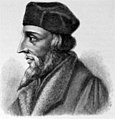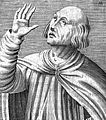Előreformátor
Megjelenés
Előreformátoroknak nevezik azokat a személyeket, akik a középkor második felében az egyházat reformpróbálkozásokkal próbálták megújítani, a 16. századi reformációt megelőzően.
A négy nagy előreformátor
[szerkesztés]
A négy fő személy a wormsi Luther-emlékmű talapzatán, annak lábainál láthatóak. Mindannyian újítást akartak vinni az egyház életébe, de a tényleges megújításig nem jutottak el.[1]
- Pierre Valdes (Vald Péter) (1140 k. – 1218 előtt) – Franciaország
- John Wycliffe (Wycliff János) (1320 – 1384) – Anglia
- Ján Hus (Husz János) (1369 – 1415) – Csehország
- Girolamo Savonarola (1452 – 1498) – Itália. A Luther-emlékműn való szereplésével ellentétben előreformációs szerepe vitatott.
Más reformerek
[szerkesztés]- Orbais-i Gottschalk ( 808 – 868 ) - Németország[2][3][4]
- Tours-i Berengár (999 - 1088) - Franciaország [5][6][7]
- Bruysi Péter (12. század) - Franciaország [8][9]
- Lorenzo Valla (1407 – 1457) - Itália[10]
- Wessel Gansfort (1419 – 1489) - Hollandia[11]
- Jacques Lefèvre d'Étaples ( 1455 - 1536) - Franciaország[12][13]
Mozgalmak
[szerkesztés]Képgaléria
[szerkesztés]-
Vald Péter szobra a wormsi Luther-emlékművön
-
Girolamo Savonarola (Fra Bartolomeo festménye, kb. 1498)
-
Wessel Gansfort
-
Jacques Lefèvre d'Étaples
-
Tours-i Berengár
Jegyzetek
[szerkesztés]- ↑ Krisztus tanúi a változó világban (ISBN 963-7470-80-8)
- ↑ Gottschalk Of Orbais | Roman Catholic theologian (angol nyelven). Britannica.com . (Hozzáférés: 2021. október 27.)
- ↑ caryslmbrown: Reformation parallels: the case of Gottschalk of Orbais (angol nyelven). Doing History in Public , 2017. július 18. (Hozzáférés: 2021. október 27.)
- ↑ Lockridge, Kenneth R.. „Gottschalk "Fulgentius" of Orbais”.
- ↑ Minton, Gretchen E.. John Bale's 'The Image of Both Churches' (angol nyelven). Springer Science & Business Media (2014. január 26.). ISBN 978-94-007-7296-0 „Berengar of Tours was an 11th-century theologian who argued that the doctrine of transubstantiation was contrary to reason and unsupported by scripture”
- ↑ Siebeck, Mohr. Prophecy, Piety, and the Problem of Historicity: Interpreting the Hebrew, 372. o. (2016. március 11.). ISBN 978-3-16-154270-1 „Berengar of Tours (c. 1005-1088), Bernand of Clairvaux, the Waldensians in the twelth century, the Albigensians in the thriteenth century and John Wycliffe (x. 1330-1385) and Jan Hus (c. 1370-1415) in the fourtheenth and fifteenth centuries, are all prefigured in the poetic images of Solomon's Songs. They all become forerunners of Luther and Calvin”
- ↑ The Grail Legend (angol nyelven). Princeton University Press (1998. január 2.). ISBN 978-0-691-00237-8 „Berengar of Tours (first half og the eleventh century), whose views occasioned the dispute known as the Second Eucharistic Controversy. Berengar aught that the body and the blood of the Lord were no "real" in the Eucharist but a specific image or likeleness ("figuram quandam similitudinem"). He was thus a forerunner of the Reformers.”
- ↑ Edmund Hamer Broadbent: Zarándok Gyülekezet
- ↑ Daily, John R. (1897). Primitív monitor . Greenfield, IN, USA. 422–425.
- ↑ Philip Schaff: History of the Christian Church, Volume VI: The Middle Ages. A.D. 1294-1517 - Christian Classics Ethereal Library. www.ccel.org . (Hozzáférés: 2021. december 23.)
- ↑ (2016. január 2.) „The forms of communication employed by the Protestant Reformers and especially Luther and Calvin”. Pharos Journal of Theology 98. „John of Wessel was one member in the group who attacked indulgences (Reddy 2004:115). The doctrine of justification by faith alone was the teaching of John of Wessel (Kuiper 1982:151). He rejected the doctrine of transubstantiation where it is believed when the priest pronounces the sacraments then the wine and bread in turned into the real body and blood of Christ”
- ↑ Jacques Lefèvre d'Etaples (1450-1537). Musée protestant . (Hozzáférés: 2021. december 31.)
- ↑ Philip Schaff: History of the Christian Church, Volume VI: The Middle Ages. A.D. 1294-1517 - Christian Classics Ethereal Library. www.ccel.org . (Hozzáférés: 2021. december 23.)







